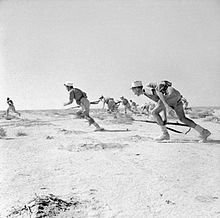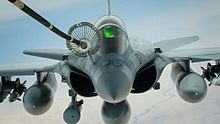French Armed Forces
| French Armed Forces | |
|---|---|
| Forces armées françaises | |
 Emblem of the French Defence Staff | |
| Service branches | |
| Percent of GDP | 1.9% (2022)[1] |
| Industry | |
| Domestic suppliers | |
| Foreign suppliers | |
| Annual imports | US$84 million (2014–2022)[2] |
| Annual exports | US$2.60 billion (2014–2022)[2] |
| Related articles | |
| History | Military history of France Warfare directory of France Wars involving France Battles involving France |
| Ranks | Army ranks Navy ranks Air and Space Force ranks |
The French Armed Forces (
History
The military history of France encompasses an immense panorama of conflicts and struggles extending for more than 2,000 years across areas, including modern France, greater Europe, and French territorial possessions overseas. According to British historian Niall Ferguson, the French participated in 50 of the 125 major European wars that have been fought since 1495; more than any other European state. They are followed by the Austrians who fought in 47 of them, the Spanish in 44 and the English (and later British) who were involved in 43. In addition, out of all recorded conflicts which occurred since the year 387 BC, France has fought in 168 of them, won 109, lost 49 and drawn 10.[7]
The Gallo-Roman conflict predominated from 60 BC to 50 BC, with the Romans emerging victorious in the conquest of Gaul by Julius Caesar. After the decline of the Roman Empire, a Germanic tribe known as the Franks took control of Gaul by defeating competing tribes. The "land of Francia," from which France gets its name, had high points of expansion under kings Clovis I and Charlemagne. In the Middle Ages, rivalries with England and the Holy Roman Empire prompted major conflicts such as the Norman Conquest and the Hundred Years' War. With an increasingly centralized monarchy, the first standing army since Roman times, and the use of artillery, France expelled the English from its territory and came out of the Middle Ages as the most powerful nation in Europe, only to lose that status to Spain following defeat in the Italian Wars. The Wars of Religion crippled France in the late 16th century, but a major victory over Spain in the Thirty Years' War made France the most powerful nation on the continent once more. In parallel, France developed its first colonial empire in Asia, Africa, and in the Americas. Under Louis XIV, France achieved military supremacy over its rivals, but escalating conflicts against increasingly powerful enemy coalitions checked French ambitions and left the kingdom bankrupt at the opening of the 18th century.

Resurgent French armies secured victories in dynastic conflicts against the
Following defeat in the
The imperative of avoiding a third Franco-German conflict on the scale of those of two world wars paved the way for
International stance
Today, French military doctrine is based on the concepts of national independence, nuclear deterrence (see
Since the end of the
White Papers
2008
On 31 July 2007, President
2013
In May 2014, high ranking defence chiefs of the French Armed Forces threatened to resign if the defence budget received further cuts on top of those already announced in the 2013 White Paper. They warned that further cuts would leave the armed forces unable to support operations abroad.[12]
Recent operations
There are currently 36,000 French troops
The French Joint Force and Training Headquarters (État-Major Interarmées de Force et d'Entraînement) at Air Base 110 near
Exercises

France participates in several recurring exercises with other nations, including:
- CRUZEX, joint aerial combat training exercises in Brazil.[14][15]
- Caraibe 2013, every two years in the Caribbean, centering on Martinique and Guadeloupe.[16]
- Croix du Sud, in New Caledonia every two years with Australia, New Zealand, the United States and other Pacific nations.
- Varuna, an annual naval exercise with India.
- NATO Air Defender 2023, the largest deployment exercise in NATO's history.
In 2023, Exercise Orion, the largest in decades, is to be held in the Champagne-Ardenne region. About 10,000 soldiers are expected to take part, along with the French navy and possibly forces from Belgium, Britain, and the United States.[17]
Personnel

The head of the French armed forces is the
It breaks down as follows (2022):[19]
- The French Army; 118,600 personnel.
- The French Air and Space Force; 43,597 personnel.
- The French Navy; 36,044 personnel.
- Tri-service DGA; 17,647 personnel in medical, support and administrative roles, and in the acquisition of weapon systems.
The reserve element of the French Armed Forces consists of two structures; the Operational Reserve and the Citizens Reserve. As of 2022 the strength of the Operational Reserve is 25,785 personnel.[18]
Apart from the three main service branches, the French Armed Forces also includes a fourth military branch called the National Gendarmerie. It had a reported strength of 103,000 active personnel and 25,000 reserve personnel in 2018.[20] They are used in everyday law enforcement, and also form a coast guard formation under the command of the French Navy. There are however some elements of the Gendarmerie that participate in French external operations, providing specialised law enforcement and supporting roles.
Historically the National Guard functioned as the Army's reserve national defense and law enforcement militia. After 145 years since its disbandment, due to the risk of terrorist attacks in the country, the Guard was officially reactivated, this time as a service branch of the Armed Forces, on 12 October 2016.[21]
Since 2019 young French citizens can fulfill the mandatory service Service national universel (SNU) within the Armed Forces in the service branch of their choice.[22][23]
Organisation and service branches
Placed under the command of the staffs, the French armed forces include the five service branches, the Army, the National Navy, the Air and Space Force, the National Gendarmerie, and the National Guard, as well as the support services and joint organizations:[24]
French Army (Armée de terre)
- Special Forces
- Airborne Units (Troupes aéroportées)
- Infantry (Infanterie)
- Armoured Cavalry (Arme blindée cavalerie)
- Artillery (Artillerie)
- Foreign Legion (Légion étrangère)
- Troupes de Marine
- French Army Light Aviation (Aviation légére de l'armée de terre, ALAT)
- Engineers (Génie)
- Paris Fire Brigade (brigade des sapeurs-pompiers de Paris)
- Signal Corps (Transmissions)
- Transport and logistics (Train)
- Matériel (Supply)
- Intelligence (Renseignement)
-
A Leclerc tank during manoeuvres
-
Bastille Day military parade in Paris, 2017
-
French soldier with a FAMAS rifle
-
AMX-10 RC armoured fighting vehicle
-
Sniper with the FR F2 rifle
-
A Eurocopter Tiger attack helicopter
- Parachute Units of the French Navy
- Naval Commandos(Fusiliers Marins)
- Naval Air Arm(Aviation navale)
- Submarine Force (Forces sous-marines)
- Naval Action Force(Force d'action navale)
- The Marseille Marine Fire Battalion
In addition, the National Gendarmerie form a Coast Guard force called the Gendarmerie Maritime which is commanded by the French Navy.
-
Triomphant class nuclear ballistic missile submarine
-
The aircraft carrier Charles de Gaulle (R91)
-
The destroyer Forbin (D620)
-
The destroyer Auvergne (D654)
-
Nuclear submarine Casabianca (S603)
-
French amphibious assault ship Dixmude (L9015)
French Air and Space Force (Armée de l'Air et de l'Espace)
- French Space Command
- Parachute Units of the French Air and Space Force
- Air and space force ground troops (Fusiliers Commandos de l'Air)
- Paratroopers/Special forces(Commando parachutiste de l'air)
- Territorial Air Defence
-
A Rafale multirole fighter aircraft
-
A Mirage 2000D fighter-bomber aircraft
-
Boeing E-3F Sentry AWACS aircraft
-
A330 MRTT strategic aerial refueling aircraft
-
Airbus A400M Atlas transport aircraft
-
MQ-9 Reapercombat UAV
National Gendarmerie (Gendarmerie nationale)
- Parachute Units of the National Gendarmerie
- Gendarmerie Départementale (GD) – territorial police force
- Gendarmerie Mobile (GM) – anti-riot unit and counter-terrorism group (GIGN)
- Garde républicaine – republican guard of France
- Gendarmerie des Transports Aériens – airport security force
- Gendarmerie de l'Air – used for Air and Space Force security
- Gendarmerie Maritime – coast guard unit
- Provost Gendarmerie – provides military police services to French Armed Forces personnel in deployments outside France
- Overseas Gendamerie – provides military police services in the French overseas dependencies and territories, as well as to embassies of France abroad
The National Gendarmerie is primarily a military and airborne capable police force which serves as a rural and general purpose police force.
National Guard (Garde nationale)
Reactivated in 2016, the National Guard serves as the official primary military and police reserve service of the Armed Forces. It is placed under the jurisdiction of
See also
- Bastille Day Military Parade
- Combined Joint Expeditionary Force (CJEF)
- Foreign Legion
- Troupes de Marine
- Military history of France
- National Office for Veterans and Victims of War
- The Lancaster House Treaties (2010)
- List of equipment of the French Army
- List of active military aircraft of the French Armed Forces
References
- ^ "Trends in World Military Expenditure, 2022" (PDF). Stockholm International Peace Research Institute. April 2023. Retrieved 29 April 2023.
- ^ a b "TIV of arms imports/exports data for France, 2014–2022". Stockholm International Peace Research Institute. 30 January 2024.
- ^ "Military expenditure by country, in constant (2015) US$ m., 2007–2016 (table)" (PDF). Stockholm International Peace Research Institute. Retrieved 18 August 2017.
- ^ https://www.defense.gouv.fr/chiffres-cles-defense-2021
- ^ https://www.senat.fr/rap/r07-271/r07-2719.html#:~:text=La%20gendarmerie%20compte%20aujourd'hui,l'arm%C3%A9e%20de%20terre).
- ^ O’Sullivan, Michael; Subramanian, Krithika (2015-10-17). The End of Globalization or a more Multipolar World? (Report). Credit Suisse AG. Archived from the original on 15 February 2018. Retrieved 2017-07-14.
- ^ Ferguson, Niall (2001). "The Cash Nexus: Money and Power in the Modern World, 1700–2000; p.25-27". www.goodreads.com. Retrieved 2020-07-05.
- ^ Richard Brooks (editor), Atlas of World Military History. p. 101. "Washington's success in keeping the army together deprived the British of victory, but French intervention won the war."
- ^ Blair, W. Granger (13 February 1960). "France Explodes Her First A-Bomb in a Sahara Test". New York Times. p. 1. Retrieved 5 November 2010.
- ^ Official Presidential Website, Letter of Engagement to M. Jean-Claude Mallet, 31 July 2007 Archived 21 September 2008 at the Wayback Machine
- ^ Jim Hoagland, "France's Whirlwind of Change", Real Clear Politics, 18 June 2008 [1]
- ^ Samuels, Henry (23 May 2014). "French Military Heads Threaten to Resign Over 'Grave' Defense Cuts". www.atlanticcouncil.org. Telegraph. Retrieved 27 May 2014.
- ^ [2] Archived June 5, 2010, at the Wayback Machine
- ^ FAB In CRUZEX IV Coalition Force's backstage
- ^ FAB CRUZEX IV Archived 2011-07-19 at the Wayback Machine (in Portuguese)
- ^ "FRENCH MILITARY EXERCISE – CARAIBE 2013". La France dans la Caraïbe. Government of France. 3 May 2013. Retrieved 8 May 2021.
- ^ "The French armed forces are planning for high-intensity war". The Economist. 31 March 2021. Retrieved 8 May 2021.
- ^ a b "Chiffres clés de la Défense – 2017" (in French). Defense.gouv.fr. Archived from the original on 2018-02-18. Retrieved 2018-06-29.)
- ^ "defense.gouv.fr". www.defense.gouv.fr. Retrieved 2022-03-28.
- ^ [3], gendarmerie.interieur.gouv.fr, 2018
- ^ Corbet, Sylvie (8 August 2017). "France creates National Guard to battle terrorism".
- ^ Text by: FRANCE 24 Follow (16 June 2019). "France begins trial of compulsory civic service for teens". France24.com. Retrieved 2020-06-02.
{{cite web}}: CS1 maint: numeric names: authors list (link) - ^ Williamson, Lucy (2019-06-26). "France's raw recruits sign up for return of national service – BBC News". Bbc.com. Retrieved 2020-06-02.
- ^ "Article L3211-1 du code de la Défense". www.legifrance.gouv.fr. Retrieved 2022-02-23.
Bibliography
- IISS (2021). The Military Balance 2021. Routledge. ISBN 978-1032012278.
External links
- Official site of the French Ministry of Defence
- French Military Strategy and NATO Reintegration—Council on Foreign Relations
- French Army rank insignia


















